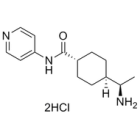Metformin hydrochloride
(HB2153)
Certificate of Analysis
Product overview
| Name | Metformin hydrochloride |
| Description | LKB1/AMPK activator. Also promotes neurogenesis. |
Write Your Own Review
Biological Data
| Biological description | LKB1/AMPK activator which is blood brain barrier permeable. It improves insulin sensitivity and decreases plasma glucose levels to show antidiabetic activity. Additionally, it displays antiproliferative effects in cancer cell lines, inhibits cancer stem cells (CSCs) and shows anticancer and anti-neoplastic effects. It also promotes neurogenesis by activating the PKC-CBP pathway. Recently investigated as part of COVID-19 compound repurposing. |
Solubility & Handling
| Solubility overview | Soluble in water (100mM) or DMSO (50mM) |
| Storage instructions | Room temperature |
| Storage of solutions | Prepare and use solutions on the same day if possible. Store solutions at -20°C for up to one month if storage is required. Equilibrate to RT and ensure the solution is precipitate free before use. |
| Shipping Conditions | Stable for ambient temperature shipping. Follow storage instructions on receipt. |
| Important | This product is for RESEARCH USE ONLY and is not intended for therapeutic or diagnostic use. Not for human or veterinary use. |
Chemical Data
| Chemical name | N,N-Dimethylimidodicarbonimidic diamide hydrochloride |
| Molecular Weight | 165.62 |
| Chemical structure | ![Metformin hydrochloride | [1115-70-4] Metformin hydrochloride | [1115-70-4] Chemical Structure](https://cdn.hellobio.com/media/catalog/product//h/b/hb2153_3.png) |
| Molecular Formula | C4H11N5.HCl |
| CAS Number | 1115-70-4 |
| PubChem identifier | 14219 |
| SMILES | CN(C)C(=N)N=C(N)N.Cl |
| InChi | InChI=1S/C4H11N5.ClH/c1-9(2)4(7)8-3(5)6;/h1-2H3,(H5,5,6,7,8);1H |
| InChiKey | OETHQSJEHLVLGH-UHFFFAOYSA-N |
| MDL number | MFCD00012582 |
| Appearance | White solid |
References for Metformin hydrochloride
References are publications that support the biological activity of the product
-
A SARS-CoV-2 protein interaction map reveals targets for drug repurposing
Krogan et al (2020) Nature 7816 : 459-468 -
Metformin, cancer and glucose metabolism.
Salani et al (2014) Endocr Relat Cancer 21(6) : 461-71 -
Metformin activates an atypical PKC-CBP pathway to promote neurogenesis and enhance spatial memory formation.
Wang et al (2012) Cell Stem Cell 11(1) : 23-35 -
AMP-activated protein kinase in metabolic control and insulin signaling.
Towler and Hardie (2007) Circ Res 100(3) : 32841





 Understanding purity and quality - a guide for life scientists
Understanding purity and quality - a guide for life scientists
